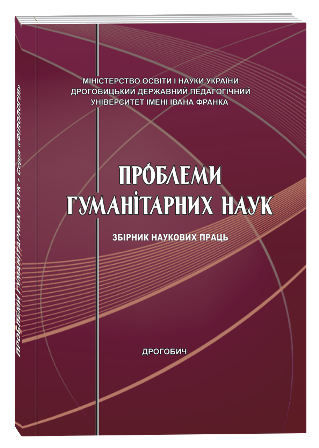“WENIG” – FROM AN ADJECTIVE TO AN UNSPECIFIED NUMBER EXPRESSION
DOI:
https://doi.org/10.24919/2522-4565.2021.46.20Keywords:
number, quantity, origin of numerals, unspecified quantity indicator, language diachronyAbstract
The ability to calculate, the ability to perceive the quantity, a certain expertise in grouping, combining, and splitting belong to the area of mathematical thinking, which, in its turn, to the basic functions of the human brain. Nowadays, in modern language, people implement all these skills on each structural level – phonetic, syntactic, morphemic, and others. How word-groups containing the quantitative notion expand, grow and multiply is currently unknown to linguists, but the new approaches to data analysis, studying and systematizing of the results can indisputably open access to a deeper understanding of the subject. This article discusses the formation of a group of relative quantifying expressions in the German language with the chronological development of the unspecified quantity indicator “wenig”. By giving examples from literary records of Old German, Middle High German and Early Modern German languages we analyse the way in which the adjective “wenig” has evolved into a relative quantity indicator, having completely changed its meaning. It is likely to have been created, in the Proto-Germanic language by substantiation of the verb cry, its first meaning as an independent nominative morpheme is the semantic field “pathetic, pitiful, wretched, miserable, sumptuous, sad”, Gradually, under the pressure of a more dominant noun, it acquires the characteristics of an adjective and begins to be concorded with its lexical determinator (noun of the nominee and/or a complementary word) in all categories necessary – gender, number, case. Over time, the meaning mutates into a quantitative – “little, few”. And finally, during the late Middle Ages, it consolidates in two capacities – as an ordinary adjective, which follows all the rules of inflection, and as a significant quantificator, which can accompany lexical constructions, endowing them with a relative quantitative meaning. The author foresees prospects for the further research in working with bigger data and using mathematical models to recreate the process.
References
Гамкрелидзе Т.В., Иванов В.В. Индоевропейский язык и индоевропейцы. Тбилиси : Издательство Тбилисс. университета, 1984. 1317 с.
Звонська Л.Л., Корольова Н.В., Лазер-Паньків О.В. Енциклопедичний словник класичних мов : енциклопедичний словник. 2-ге вид. Київ : ВПЦ «Київський ун-т», 2017. 552 с.
Левицкий В.В. Этимологические и семасиологические исследования в области германских языков области. Черновцы : ЧГУ, 1997. 276 с.
Мажюлис В., Журавлёв В.К., Нерознак В.П. Сравнительно-историческое изучение языков разных семей. Современное состояние и проблемы. Москва : Наука, 1981. 356 с.
Таранец В.Г. Происхождение понятия числа и его языковой реализации. Одесса : Астропринт, 1999. 116 с.
Authier J.-M. Split quantification and the status of adjunction in the theory of grammar. Studia linguistica. № 68. P. 245–283.
Behagel O. Deutsche Syntax: Eine geschichtliche Darstellung. Heidelberg, 1923. 2400 p.
Cardinaletti A.G., Giusti G. The syntax of quantified phrases and quantitative clitics. Oxford : Blackwell, 2006. 61p.
Ebert, Robert Peter, Reichmann, Oskar, Solms, Hans-Joachim & Wegera, Klaus-Peter. Frühneuhochdeutsche Grammatik. Tübingen : Max Niemeyer, 1993. 679 p.
Fleischer J. Historische Syntax des Deutschen: Eine Einführung. Frühneuhochdeutsche Grammatik. Tübingen : Max Niemeyer, 1997. 359 p.
Köbler G. Althochdeutsches Wörterbuch. URL: http://www.koeblergerhard.de/ahdwbhin.html (date of access: 24.08.2021).
Menninger K. Number words and number symbols: a cultural history of numbers. Cambridge, Mass : M.I.T. Press, 1992. 513 p.
Pfeifer W. Etymologisches Wörterbuch des Deutschen. München : DTV, 2014. 1665 p.
Roehrs D., Sapp C. Quantifying expressions in the history of german syntactic reanalysis and morphological change. John Benjamins Publishing Company, 2016. 299 p.



